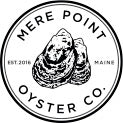Our Oysters
Flavor Profile
Nurtured in the rolling waters of pristine Mere Point, Maquoit & Middle Bays, our oysters present a crisp, dense meat with high salinity and a clean bright finish. From nursery to harvest , they are grown in these nutrient rich bays where large tidal exchanges offer a diverse variety of phytoplankton for healthy growth, and colder waters for shell strength and excellent plump meats. Combined with multiple handling’s in the tumbler and hand selection, Mere Points come to harvest with strong beautiful shells, durability, and a classic Maine brininess.
Taste: Salty & Sweet
Texture: Smooth, Meaty & Clean
Finish: Earthy, Umami
Brine Scale: 5
Salt Point Range: 26-31
ORDER HERE
Growing Process
Seeding
Our oysters first meet the waters of Maquoit and Mere Point Bays when they are just a couple weeks old and only 2mm long – about the size of the end of a felt-tipped pen.
Each spring, these “seed” oysters arrive in bags. The bags are marked “Handle with Care” as these tiny oysters are very fragile. We carefully spread these babies out onto small floating nursery trays made with extra fine 500-micron mesh.
A fat grain of sand can’t even fit through that. We flip the trays every day to help keep other plants and animals from growing on them. In a couple weeks, they will have tripled in size and will be as big as a pencil eraser. When they reach this size, we split the density and move the oysters into bags with slightly bigger holes. This allows them more space to filter water and feed.
Setting Out
Once those babies are big enough, they are ready to leave the nursery and grow out in the Bay. We sort them using a 1/4’” mesh tray to see which ones have grown enough to leave the nursery.
We put the oysters into fine mesh bags suspended from floats on the surface. This all takes place at one of our lease sites. Once they’re in these bags, they really start to grow!
Growing Season
Over the summer, our oysters will start to get a little crowded. We give them more room to grow by splitting them into more grow out bags. Each time we sort them, we check on their health and measure their growth rate.
We also tumble them in our solar-powered tumbler to brake off extra bits of shell around the edges. This helps the oyster focus on growing its soft delicious body rather than its shell. Tumbling also shapes the oyster into a nice deep cup, full of liquor and perfect for slurping. This happens several times over the summer.
Putting to Bed
By November, our babies are about the size of a quarter or about 1 inch or so. They’ve still got at least another year of growth before reaching market size. The water in our bays are get cold and our oysters slow their growth. this means, it’s time to put our oysters to bed for the winter.
Here’s why the floating cages are pretty cool. We can sink them to the bottom for the winter where the temperature will be more constant and they won’t get beat-up by the sea ice and winter storms. They’ll stay there until next spring. Before we do that, we tumble our oysters and separate them into lower densities.
Hauling Up
Once spring comes around, we haul up the cages and make observations about their survival over the winter. They’re still not ready for harvest, but some of them may be by early fall.
We hang them up on the floats again where they will get plenty of cool, clear, nutrient rich water circulating around them. This allows for optimal feeding, since this is where the algae and phytoplankton that oysters feed on lives.
In addition to our traditional grow out bags, we put some oysters in Seapa bags – neat, cylindrical bags. These bags hang down from a line between our cages. These get more constant water action, which breaks the shell edges off and helps them grow a deeper cup.
Once everything is off the bottom, floating happily in Mere Point Bay and Maquoit Bay and the waters have warmed up, we buy more seed to start the next generation!
Harvest
After growing for two years, some of our oysters are ready to be harvested. These measure about 2 ½“ in size. We leave some a bit longer to reach the select size – around 3”.
To harvest them, we pull the grow out bags out of our cages and we bring them to our float (located in the middle of Maquoit Bay) where we wash them with fresh seawater, tag each bin of oysters and get them back to out cold storage immediately. We sort them by hand at this point, grading them by size and quality.


